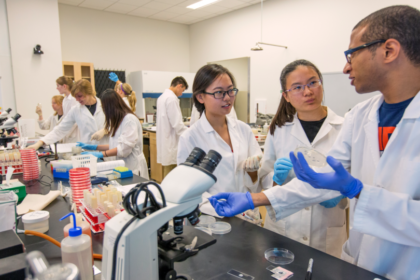
By Neal Vitale
Universities across the globe are struggling not only with how to educate incoming and returning students but with safe reopening of their research labs. Much of their focus is on the same approaches broadly recommended by health officials – social distancing, mandatory face masks, daily health screening and contact tracing.
“It’s been a ton of work for everyone – intellectually to develop new policies, physically to rearrange and manage buildings and administratively to manage work calendars and class schedules across a large campus,” says Abigail Snyder, assistant professor of microbial food safety at Cornell University. “Besides the resources involved in getting these plans off the ground, these policies necessarily mean that we’re operating at reduced in-person capacity and that there are budgetary shortfalls.”
Professor of Food Science at the University of Nebraska-Lincoln Bob Hutkins reports similar disruption.
“Just like everywhere, my lab shut down in late March. Only a few critical functions were maintained, but lab research was effectively halted,” Hutkins says. “Some of my graduate students, however, also perform computational research analyzing microbiome data, so those projects were less affected. Still, the two projects that were most lab-oriented happened to be focused on fermented foods. Our lab did reopen in late June, so we are now (after a 3-month delay) almost back to where we were pre-COVID.”
Maria Marco, professor in food science and technology at the University of California, Davis, (and member of the TFA Advisory Board) adds: “As the pandemic continues there is an increasing financial and emotional toll on graduate students and postdocs whose research is now significantly delayed. This toll also applies to new students. I have a new international graduate student who is supposed to start work on a food fermentation project this fall but may not receive a visa to come to the US. Although she can contribute remotely, this barrier would cause significant hardship and prolong the time needed to complete the degree.”
The situation obviously remains fluid, as noted by Barbara Ingham, professor of food science, University of Wisconsin-Madison.
“Things are changing pretty much on a weekly basis here,” Ingham says. “We were to move to Phase 2 in July; that is on indefinite hold. Our campus teaching schedule changes on a weekly (and sometimes daily) basis, etc. It’s hard to be up-to-date at this time.”
Professor of Foods and Nutrition and Extension Food Safety Specialist Elizabeth Andress at the University of Georgia echoes these themes.
“[The work] I was doing on coming up with home-based or small entrepreneur kimchi and sauerkraut variations that I was willing to put the UGA Extension name on to publicly release was ground to a halt this past winter/spring,” Andress says. “And I haven’t been back on campus since mid-February because of a fall injury followed by the pandemic restrictions, let alone reduced budgets are now not going to allow employment of help or any significant research that was self-funded pre-COVID. …policies for finding ways to do non-essential research and have multiple people in a lab are still undergoing constant new messaging and planning at UGA.”
A somewhat more positive picture emerges from Canada. Michael Ganzle is professor and Canada research chair in microbiology and probiotics at the University of Alberta.
“Fermented food products including (sourdough) bread are not on the list of products with reduced demand during the COVID-crisis. To the opposite, many started making sourdough bread during the lockdown in Alberta, and I have been contacted by many (including TV and radio stations) on how to manage with sourdough,” Ganzle adds. “Research at UAlberta was temporarily reduced due to lockdowns of some services on campus, and reduced capacity/increased safety rules, but [research] never really stopped. With one exception, extramurally funded projects or graduate thesis projects were somewhat delayed but timelines were not substantially disrupted. The picture is different for anyone using animals or humans in their research projects, or those doing field research – these ramp up only now after a three month interruption.”
He attributes the relatively modest impact of the COVID-19 pandemic on research activities to appropriate leadership at the department/university/provincial (state) level that appeared to strike an appropriate balance of safety measures to “flatten the curve” with ongoing research/economic activity.
Snyder at Cornell also underscores the efforts being aimed at facilitating both the advancement of teaching and research missions as well as supporting robust protection of public health. “In truth, I wish we had policies like these generalized more broadly across the US.”
Adds Hutkins at University of Nebraska,”As inconvenient as the shutdown has been, the main issues for my colleagues and me have been to ensure that the lab remains a safe environment, that we practice social distancing and that students and staff stay physically and emotionally healthy.”
